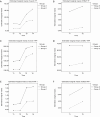Oxygenation impairment in patients with acute aortic dissection is associated with disorders of coagulation and fibrinolysis: a prospective observational study
- PMID: 31179061
- PMCID: PMC6531732
- DOI: 10.21037/jtd.2019.04.32
Oxygenation impairment in patients with acute aortic dissection is associated with disorders of coagulation and fibrinolysis: a prospective observational study
Abstract
Background: Stanford type-A acute aortic dissection (AAD) is typically accompanied by oxygenation impairment before surgery. In addition, inflammation, coagulation and fibrinolysis also impair blood oxygenation. However, our understanding of the concentration of these factors in bronchoalveolar lavage fluid (BALF) has not been reported. The objective of the study was to investigate the impact of preoperative acute lung injury (ALI) on postoperative oxygenation impairment and to explore the effect of coagulation and fibrinolysis in blood and BALF.
Methods: This investigation utilized a prospective observational study design, which was registered at www.clinicaltrials.gov (identifier NCT01894334). The study included 53 patients undergoing surgery for Stanford type-A AAD at an academic hospital in China between October 2013 and July 2014. Preoperative ALI was identified according to the oxygenation index calculated by the PaO2/FiO2 ratio. The subjects were divided into the ALI group (oxygenation index ≤300 mmHg) or the control group (oxygenation index >300 mmHg). The primary outcome was patient oxygenation index, while secondary outcomes were concentrations of tissue factor (TF), tissue factor pathway inhibitor (TFPI), and plasminogen activator inhibitor-1 (PAI-1) in serum and BALF.
Results: The incidence of preoperative ALI for Stanford type-A AAD patients was 41.5%. Stanford type-A AAD patients with preoperative ALI had a lower postoperative oxygenation index (104.6±31.7 vs. 248.7±48.0 mmHg, P<0.001), higher concentrations of TF in serum and BALF (F=133.67, P<0.001; F=68.14, P<0.001), higher concentrations of TFPI in serum and BALF (F=31.98, P<0.001; F=45.58, P<0.001), and higher concentrations of PAI-1 in serum and BALF (F=213.88, P<0.001; F=107.95, P<0.001) when compared with those without preoperative ALI. Type-A AAD patients also showed a greater loss of blood (1,524±458 vs. 1,175±327 mL, P=0.040), longer mechanical ventilation time in the ICU (27.24±8.37 vs. 17.33±7.36 h, P<0.001), longer total stay in the ICU (42.27±10.85 vs. 33.45±9.05 h, P=0.002), and longer total hospital stay (17.77±5.00 vs. 13.48±3.97 days, P=0.001). Multivariate linear regression analysis indicated that preoperative PAI-1 in BALF, and TF in both serum and BALF were significantly associated with preoperative oxygenation impairment in patients with Stanford type-A AAD.
Conclusions: Preoperative ALI caused more serious postoperative oxygenation impairment for Stanford type-A AAD, and coagulation and fibrinolysis appear to play critical roles in this process. Preoperative PAI-1 in BALF and TF in both serum and BALF were significant factors related to the occurrence of preoperative oxygenation impairment for Stanford type-A AAD.
Keywords: Acute aortic dissection (AAD); acute lung injury (ALI); coagulation; fibrinolysis; oxygenation.
Conflict of interest statement
Conflicts of Interest: The authors have no conflicts of interest to declare.
Figures

References
-
- Erbel R, Aboyans V, Boileau C, et al. 2014 ESC Guidelines on the diagnosis and treatment of aortic diseases: Document covering acute and chronic aortic diseases of the thoracic and abdominal aorta of the adult. The Task Force for the Diagnosis and Treatment of Aortic Diseases of the European Society of Cardiology (ESC). Eur Heart J 2014;35:2873-926. 10.1093/eurheartj/ehu281 - DOI - PubMed
Associated data
LinkOut - more resources
Full Text Sources
Medical
Miscellaneous
